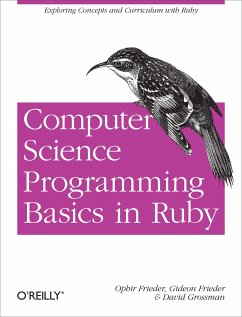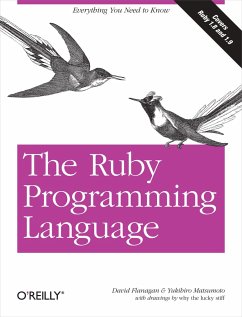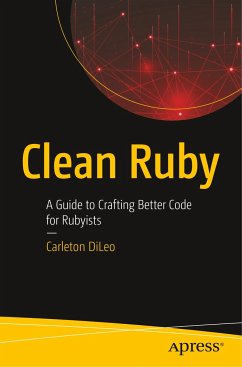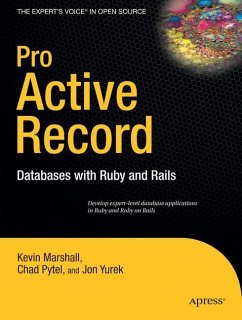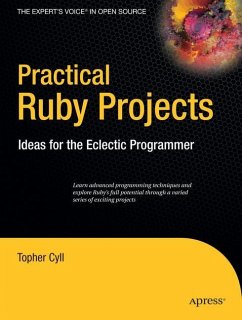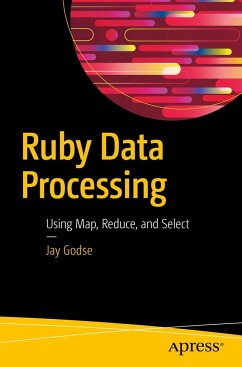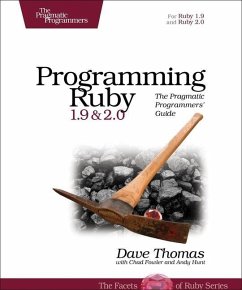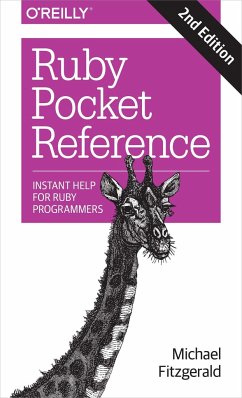Nicht lieferbar

Design Patterns in Ruby
Foreword by Obie Fernandez
Versandkostenfrei!
Nicht lieferbar
Praise for Design Patterns in Ruby
"Design Patterns in Ruby documents smart ways to resolve many problems that Ruby developers commonly encounter. Russ Olsen has done a great job of selecting classic patterns and augmenting these with newer patterns that have special relevance for Ruby. He clearly explains each idea, making a wealth of experience available to Ruby developers for their own daily work."
-Steve Metsker, Managing Consultant with Dominion Digital, Inc.
"This book provides a great demonstration of the key 'Gang of Four' design patterns without resorting to overly technical explanations. Written in a precise, yet almost informal style, this book covers enough ground that even those without prior exposure to design patterns will soon feel confident applying them using Ruby. Olsen has done a great job to make a book about a classically 'dry' subject into such an engaging and even occasionally humorous read."
-Peter Cooper
"This book renewed my interest in understanding patterns after a decade of good intentions. Russ picked the most useful patterns for Ruby and introduced them in a straightforward and logical manner, going beyond the GoF's patterns. This book has improved my use of Ruby, and encouraged me to blow off the dust covering the GoF book."
-Mike Stok
"Design Patterns in Ruby is a great way for programmers from statically typed objectoriented languages to learn how design patterns appear in a more dynamic, flexible language like Ruby."
-Rob Sanheim, Ruby Ninja, Relevance
Most design pattern books are based on C++ and Java. But Ruby is different-and the language's unique qualities make design patterns easier to implement and use. In this book, Russ Olsen demonstrates how to combine Ruby's power and elegance with patterns, and write more sophisticated, effective software with far fewer lines of code.
After reviewing the history, concepts, and goals of design patterns, Olsen offers a quick tour of the Ruby language-enough to allow any experienced software developer to immediately utilize patterns with Ruby. The book especially calls attention to Ruby features that simplify the use of patterns, including dynamic typing, code closures, and "mixins" for easier code reuse.
Fourteen of the classic "Gang of Four" patterns are considered from the Ruby point of view, explaining what problems each pattern solves, discussing whether traditional implementations make sense in the Ruby environment, and introducing Ruby-specific improvements. You'll discover opportunities to implement patterns in just one or two lines of code, instead of the endlessly repeated boilerplate that conventional languages often require.
Design Patterns in Ruby also identifies innovative new patterns that have emerged from the Ruby community. These include ways to create custom objects with metaprogramming, as well as the ambitious Rails-based "Convention Over Configuration" pattern, designed to help integrate entire applications and frameworks.
Engaging, practical, and accessible, Design Patterns in Ruby will help you build better software while making your Ruby programming experience more rewarding.
Product Description
Praise for Design Patterns in Ruby
Design Patterns in Ruby documents smart ways to resolve many problems that Ruby developers commonly encounter. Russ Olsen has done a great job of selecting classic patterns and augmenting these with newer patterns that have special relevance for Ruby. He clearly explains each idea, making a wealth of experience available to Ruby developers for their own daily work.
-Steve Metsker, Managing Consultant with Dominion Digital, Inc.
This book provides a great demonstration of the key 'Gang of Four' design patterns without resorting to overly technical explanations. Written in a precise, yet almost informal style, this book covers enough ground that even those without prior exposure to design patterns will soon feel confident applying them using Ruby. Olsen has done a great job to make a book about a classically 'dry' subject into such an engaging and even occasionally humorous read.
-Peter Cooper
This book renewed my interest in understanding patterns after a decade of good intentions. Russ picked the most useful patterns for Ruby and introduced them in a straightforward and logical manner, going beyond the GoF's patterns. This book has improved my use of Ruby, and encouraged me to blow off the dust covering the GoF book.
-Mike Stok
Design Patterns in Ruby is a great way for programmers from statically typed objectoriented languages to learn how design patterns appear in a more dynamic, flexible language like Ruby.
-Rob Sanheim, Ruby Ninja, Relevance
Most design pattern books are based on C++ and Java. But Ruby is different-and the language's unique qualities make design patterns easier to implement and use. In this book, Russ Olsen demonstrates how to combine Ruby's power and elegance with patterns, and write more sophisticated, effective software with far fewer lines of code.
After reviewing the history, concepts, and goals of design patterns, Olsen offers a quick tour of the Ruby language-enough to allow any experienced software developer to immediately utilize patterns with Ruby. The book especially calls attention to Ruby features that simplify the use of patterns, including dynamic typing, code closures, and mixins for easier code reuse.
Fourteen of the classic Gang of Four patterns are considered from the Ruby point of view, explaining what problems each pattern solves, discussing whether traditional implementations make sense in the Ruby environment, and introducing Ruby-specific improvements. You'll discover opportunities to implement patterns in just one or two lines of code, instead of the endlessly repeated boilerplate that conventional languages often require.
Design Patterns in Ruby also identifies innovative new patterns that have emerged from the Ruby community. These include ways to create custom objects with metaprogramming, as well as the ambitious Rails-based Convention Over Configuration pattern, designed to help integrate entire applications and frameworks.
Engaging, practical, and accessible, Design Patterns in Ruby will help you build better software while making your Ruby programming experience more rewarding.
Backcover
Praise for Design Patterns in Ruby
Design Patterns in Ruby documents smart ways to resolve many problems that Ruby developers commonly encounter. Russ Olsen has done a great job of selecting classic patterns and augmenting these with newer patterns that have special relevance for Ruby. He clearly explains each idea, making a wealth of experience available to Ruby developers for their own daily work.
-Steve Metsker, Managing Consultant with Dominion Digital, Inc.
This book provides a great demonstration of the key 'Gang of Four' design patterns without resorting to overly technical explanations. Written in a precise, yet almost informal style, this book covers enough ground that even those without prior exposure to design patterns will soon feel confident applying them using Ruby. Olsen has done a great job to make a book about a classically 'dry' subject into such an engaging and even occasionally humorous read.
-Peter Cooper
This book renewed my interest in understanding patterns after a decade of good intentions. Russ picked the most useful patterns for Ruby and introduced them in a straightforward and logical manner, going beyond the GoF's patterns. This book has improved my use of Ruby, and encouraged me to blow off the dust covering the GoF book.
-Mike Stok
Design Patterns in Ruby is a great way for programmers from statically typed objectoriented languages to learn how design patterns appear in a more dynamic, flexible language like Ruby.
-Rob Sanheim, Ruby Ninja, Relevance
Most design pattern books are based on C++ and Java. But Ruby is different-and the language's unique qualities make design patterns easier to implement and use. In this book, Russ Olsen demonstrates how to combine Ruby's power and elegance with patterns, and write more sophisticated, effective software with far fewer lines of code.
After reviewing the history, concepts, and goals of design patterns, Olsen offers a quick tour of the Ruby language-enough to allow any experienced software developer to immediately utilize patterns with Ruby. The book especially calls attention to Ruby features that simplify the use of patterns, including dynamic typing, code closures, and mixins for easier code reuse.
Fourteen of the classic Gang of Four patterns are considered from the Ruby point of view, explaining what problems each pattern solves, discussing whether traditional implementations make sense in the Ruby environment, and introducing Ruby-specific improvements. You'll discover opportunities to implement patterns in just one or two lines of code, instead of the endlessly repeated boilerplate that conventional languages often require.
Design Patterns in Ruby also identifies innovative new patterns that have emerged from the Ruby community. These include ways to create custom objects with metaprogramming, as well as the ambitious Rails-based Convention Over Configuration pattern, designed to help integrate entire applications and frameworks.
Engaging, practical, and accessible, Design Patterns in Ruby will help you build better software while making your Ruby programming experience more rewarding.
Foreword xviiPreface xixAcknowledgments xxvAbout the Author xxviiPART I: Patterns and Ruby 1 Chapter 1: Building Better Programs with Patterns 3 The Gang of Four 4
Patterns for Patterns 4
Separate Out the Things That Change from Those That Stay the Same 5
Program to an Interface, Not an Implementation 5
Prefer Composition over Inheritance 7
Delegate, Delegate, Delegate 12
You Ain't Gonna Need It 13
Fourteen Out of Twenty-Three 15
Patterns in Ruby? 17
Chapter 2: Getting Started with Ruby 19 Interactive Ruby 20
Saying Hello World 20
Variables 23
Fixnums and Bignums 24
Floats 26
There Are No Primitives Here 26
But Sometimes There Is No Object 27
Truth, Lies, and nil 28
Decisions, Decisions 30
Loops 32
More about Strings 34
Symbols 37
Arrays 38
Hashes 40
Regular Expressions 40
A Class of Your Own 41
Getting at the Instance Variables 43
An Object Asks: Who Am I? 46
Inheritance, Subclasses, and Superclasses 46
Argument Options 47
Modules 49
Exceptions 52
Threads 53
Managing Separate Source Files 54
Wrapping Up 55
PART II: Patterns in Ruby 57 Chapter 3: Varying the Algorithm with the Template Method 59 Keeping Up with What Life Throws at You 60
Separate the Things That Stay the Same 61
Discovering the Template Method Pattern 65
Hook Methods 66
But Where Are All the Declarations? 68
Types, Safety, and Flexibility 69
Unit Tests Are Not Optional 71
Using and Abusing the Template Method Pattern 73
Templates in the Wild 74
Wrapping Up 75
Chapter 4: Replacing the Algorithm with the Strategy 77 Delegate, Delegate, and Delegate Again 78
Sharing Data between the Context and the Strategy 80
Duck Typing Yet Again 82
Procs and Blocks 84
Quick-and-Dirty Strategies 88
Using and Abusing the Strategy Pattern 90
The Strategy Pattern in the Wild 90
Wrapping Up 92
Chapter 5: Keeping Up with the Times with the Observer 95 Staying Informed 95
A Better Way to Stay Informed 97
Factoring Out the Observable Support 100
Code Blocks as Observers 104
Variations on the Observer Pattern 105
Using and Abusing the Observer Pattern 106
Observers in the Wild 108
Wrapping Up 109
Chapter 6: Assembling the Whole from the Parts with the Composite 111 The Whole and the Parts 112
Creating Composites 114
Sprucing Up the Composite with Operators 118
An Array as a Composite? 119
An Inconvenient Difference 120
Pointers This Way and That 120
Using and Abusing the Composite Pattern 122
Composites in the Wild 123
Wrapping Up 125
Chapter 7: Reaching into a Collection with the Iterator 127 External Iterators 127
Internal Iterators 130
Internal Iterators versus External Iterators 131
The Inimitable Enumerable 133
Using and Abusing the Iterator Pattern 134
Iterators in the Wild 136
Wrapping Up 140
Chapter 8: Getting Things Done with Commands 143 An Explosion of Subclasses 144
An Easier Way 145
Code Blocks as Commands 147
Commands That Record 148
Being Undone by a Command 151
Queuing Up Commands 154
Using and Abusing the Command Pattern 154
The Command Pattern in the Wild 155
ActiveRecord Migrations 155
Madeleine 156
Wrapping Up 160
Chapter 9: Filling in the Gaps with the Adapter 163 Software Adapters 164
The Near Misses 167
An Adaptive Alternative? 168
Modifying a Single Instance 170
Adapt or Modify? 172
Using and Abusing the Adapter Pattern 173
Adapters in the Wild 173
Wrapping Up 174
Chapter 10: Getting in Front of Your Object with a Proxy 175 Proxies to the Rescue 176
The Protection Proxy 178
Remote Proxies 179
Virtual Proxies Make You Lazy 180
Eliminating That Proxy Drudgery 182
Message Passing and Methods 183
The method_missing Method 184
Sending Messages 185
Proxies without the Tears 185
Using and Abusing Proxies 189
Proxies in the Wild 190
Wrapping Up 192
Chapter 11: Improving Your Objects with a Decorator 193 Decorators: The Cure for Ugly Code 193
Formal Decoration 200
Easing the Delegation Blues 200
Dynamic Alternatives to the Decorator Pattern 201
Wrapping Methods 202
Decorating with Modules 202
Using and Abusing the Decorator Pattern 204
Decorators in the Wild 205
Wrapping Up 206
Chapter 12: Making Sure There Is Only One with the Singleton 207 One Object, Global Access 207
Class Variables and Methods 208
Class Variables 208
Class Methods 209
A First Try at a Ruby Singleton 211
Managing the Single Instance 212
Making Sure There Is Only One 213
The Singleton Module 214
Lazy and Eager Singletons 214
Alternatives to the Classic Singleton 215
Global Variables as Singletons 215
Classes as Singletons 216
Modules as Singletons 218
A Safety Harness or a Straitjacket? 219
Using and Abusing the Singleton Pattern 220
They Are Really Just Global Variables, Right? 220
Just How Many of These Singletons Do You Have? 221
Singletons on a Need-to-Know Basis 221
Curing the Testing Blues 223
Singletons in the Wild 224
Wrapping Up 225
Chapter 13: Picking the Right Class with a Factory 227 A Different Kind of Duck Typing 228
The Template Method Strikes Again 231
Parameterized Factory Methods 233
Classes Are Just Objects, Too 236
Bad News: Your Program Hits the Big Time 237
Bundles of Object Creation 239
Classes Are Just Objects (Again) 241
Leveraging the Name 242
Using and Abusing the Factory Patterns 244
Factory Patterns in the Wild 244
Wrapping Up 246
Chapter 14: Easier Object Construction with the Builder 249 Building Computers 250
Polymorphic Builders 253
Builders Can Ensure Sane Objects 256
Reusable Builders 257
Better Builders with Magic Methods 258
Using and Abusing the Builder Pattern 259
Builders in the Wild 259
Wrapping Up 260
Chapter 15: Assembling Your System with the Interpreter 263 The Right Language for the Job 264
Building an Interpreter 264
A File-Finding Interpreter 267
Finding All the Files 267
Finding Files by Name 268
Big Files and Writable Files 269
More Complex Searches with Not, And, and Or 270
Creating the AST 272
A Simple Parser 272
A Parser-less Interpreter? 274
Let XML or YAML Do the Parsing? 276
Racc for More Complex Parsers 277
Let Ruby Do the Parsing? 277
Using and Abusing the Interpreter Pattern 277
Interpreters in the Wild 278
Wrapping Up 279
PART III: Patterns for Ruby 281 Chapter 16: Opening Up Your System with Domain-Specific Languages 283 The Domain of Specific Languages 283
A File Backup DSL 284
It's a Data File--No, It's a Program! 285
Building PackRat 287
Pulling Our DSL Together 288
Taking Stock of PackRat 289
Improving PackRat 290
Using and Abusing Internal DSLs 293
Internal DSLs in the Wild 294
Wrapping Up 295
Chapter 17: Creating Custom Objects with Meta-programming 297 Custom-Tailored Objects, Method by Method 298
Custom Objects, Module by Module 300
Conjuring Up Brand-New Methods 301
An Object's Gaze Turns Inward 306
Using and Abusing Meta-programming 306
Meta-programming in the Wild 308
Wrapping Up 311
Chapter 18: Convention Over Configuration 313 A Good User Interface--for Developers 315
Anticipate Needs 315
Le
"Design Patterns in Ruby documents smart ways to resolve many problems that Ruby developers commonly encounter. Russ Olsen has done a great job of selecting classic patterns and augmenting these with newer patterns that have special relevance for Ruby. He clearly explains each idea, making a wealth of experience available to Ruby developers for their own daily work."
-Steve Metsker, Managing Consultant with Dominion Digital, Inc.
"This book provides a great demonstration of the key 'Gang of Four' design patterns without resorting to overly technical explanations. Written in a precise, yet almost informal style, this book covers enough ground that even those without prior exposure to design patterns will soon feel confident applying them using Ruby. Olsen has done a great job to make a book about a classically 'dry' subject into such an engaging and even occasionally humorous read."
-Peter Cooper
"This book renewed my interest in understanding patterns after a decade of good intentions. Russ picked the most useful patterns for Ruby and introduced them in a straightforward and logical manner, going beyond the GoF's patterns. This book has improved my use of Ruby, and encouraged me to blow off the dust covering the GoF book."
-Mike Stok
"Design Patterns in Ruby is a great way for programmers from statically typed objectoriented languages to learn how design patterns appear in a more dynamic, flexible language like Ruby."
-Rob Sanheim, Ruby Ninja, Relevance
Most design pattern books are based on C++ and Java. But Ruby is different-and the language's unique qualities make design patterns easier to implement and use. In this book, Russ Olsen demonstrates how to combine Ruby's power and elegance with patterns, and write more sophisticated, effective software with far fewer lines of code.
After reviewing the history, concepts, and goals of design patterns, Olsen offers a quick tour of the Ruby language-enough to allow any experienced software developer to immediately utilize patterns with Ruby. The book especially calls attention to Ruby features that simplify the use of patterns, including dynamic typing, code closures, and "mixins" for easier code reuse.
Fourteen of the classic "Gang of Four" patterns are considered from the Ruby point of view, explaining what problems each pattern solves, discussing whether traditional implementations make sense in the Ruby environment, and introducing Ruby-specific improvements. You'll discover opportunities to implement patterns in just one or two lines of code, instead of the endlessly repeated boilerplate that conventional languages often require.
Design Patterns in Ruby also identifies innovative new patterns that have emerged from the Ruby community. These include ways to create custom objects with metaprogramming, as well as the ambitious Rails-based "Convention Over Configuration" pattern, designed to help integrate entire applications and frameworks.
Engaging, practical, and accessible, Design Patterns in Ruby will help you build better software while making your Ruby programming experience more rewarding.
Product Description
Praise for Design Patterns in Ruby
Design Patterns in Ruby documents smart ways to resolve many problems that Ruby developers commonly encounter. Russ Olsen has done a great job of selecting classic patterns and augmenting these with newer patterns that have special relevance for Ruby. He clearly explains each idea, making a wealth of experience available to Ruby developers for their own daily work.
-Steve Metsker, Managing Consultant with Dominion Digital, Inc.
This book provides a great demonstration of the key 'Gang of Four' design patterns without resorting to overly technical explanations. Written in a precise, yet almost informal style, this book covers enough ground that even those without prior exposure to design patterns will soon feel confident applying them using Ruby. Olsen has done a great job to make a book about a classically 'dry' subject into such an engaging and even occasionally humorous read.
-Peter Cooper
This book renewed my interest in understanding patterns after a decade of good intentions. Russ picked the most useful patterns for Ruby and introduced them in a straightforward and logical manner, going beyond the GoF's patterns. This book has improved my use of Ruby, and encouraged me to blow off the dust covering the GoF book.
-Mike Stok
Design Patterns in Ruby is a great way for programmers from statically typed objectoriented languages to learn how design patterns appear in a more dynamic, flexible language like Ruby.
-Rob Sanheim, Ruby Ninja, Relevance
Most design pattern books are based on C++ and Java. But Ruby is different-and the language's unique qualities make design patterns easier to implement and use. In this book, Russ Olsen demonstrates how to combine Ruby's power and elegance with patterns, and write more sophisticated, effective software with far fewer lines of code.
After reviewing the history, concepts, and goals of design patterns, Olsen offers a quick tour of the Ruby language-enough to allow any experienced software developer to immediately utilize patterns with Ruby. The book especially calls attention to Ruby features that simplify the use of patterns, including dynamic typing, code closures, and mixins for easier code reuse.
Fourteen of the classic Gang of Four patterns are considered from the Ruby point of view, explaining what problems each pattern solves, discussing whether traditional implementations make sense in the Ruby environment, and introducing Ruby-specific improvements. You'll discover opportunities to implement patterns in just one or two lines of code, instead of the endlessly repeated boilerplate that conventional languages often require.
Design Patterns in Ruby also identifies innovative new patterns that have emerged from the Ruby community. These include ways to create custom objects with metaprogramming, as well as the ambitious Rails-based Convention Over Configuration pattern, designed to help integrate entire applications and frameworks.
Engaging, practical, and accessible, Design Patterns in Ruby will help you build better software while making your Ruby programming experience more rewarding.
Backcover
Praise for Design Patterns in Ruby
Design Patterns in Ruby documents smart ways to resolve many problems that Ruby developers commonly encounter. Russ Olsen has done a great job of selecting classic patterns and augmenting these with newer patterns that have special relevance for Ruby. He clearly explains each idea, making a wealth of experience available to Ruby developers for their own daily work.
-Steve Metsker, Managing Consultant with Dominion Digital, Inc.
This book provides a great demonstration of the key 'Gang of Four' design patterns without resorting to overly technical explanations. Written in a precise, yet almost informal style, this book covers enough ground that even those without prior exposure to design patterns will soon feel confident applying them using Ruby. Olsen has done a great job to make a book about a classically 'dry' subject into such an engaging and even occasionally humorous read.
-Peter Cooper
This book renewed my interest in understanding patterns after a decade of good intentions. Russ picked the most useful patterns for Ruby and introduced them in a straightforward and logical manner, going beyond the GoF's patterns. This book has improved my use of Ruby, and encouraged me to blow off the dust covering the GoF book.
-Mike Stok
Design Patterns in Ruby is a great way for programmers from statically typed objectoriented languages to learn how design patterns appear in a more dynamic, flexible language like Ruby.
-Rob Sanheim, Ruby Ninja, Relevance
Most design pattern books are based on C++ and Java. But Ruby is different-and the language's unique qualities make design patterns easier to implement and use. In this book, Russ Olsen demonstrates how to combine Ruby's power and elegance with patterns, and write more sophisticated, effective software with far fewer lines of code.
After reviewing the history, concepts, and goals of design patterns, Olsen offers a quick tour of the Ruby language-enough to allow any experienced software developer to immediately utilize patterns with Ruby. The book especially calls attention to Ruby features that simplify the use of patterns, including dynamic typing, code closures, and mixins for easier code reuse.
Fourteen of the classic Gang of Four patterns are considered from the Ruby point of view, explaining what problems each pattern solves, discussing whether traditional implementations make sense in the Ruby environment, and introducing Ruby-specific improvements. You'll discover opportunities to implement patterns in just one or two lines of code, instead of the endlessly repeated boilerplate that conventional languages often require.
Design Patterns in Ruby also identifies innovative new patterns that have emerged from the Ruby community. These include ways to create custom objects with metaprogramming, as well as the ambitious Rails-based Convention Over Configuration pattern, designed to help integrate entire applications and frameworks.
Engaging, practical, and accessible, Design Patterns in Ruby will help you build better software while making your Ruby programming experience more rewarding.
Foreword xviiPreface xixAcknowledgments xxvAbout the Author xxviiPART I: Patterns and Ruby 1 Chapter 1: Building Better Programs with Patterns 3 The Gang of Four 4
Patterns for Patterns 4
Separate Out the Things That Change from Those That Stay the Same 5
Program to an Interface, Not an Implementation 5
Prefer Composition over Inheritance 7
Delegate, Delegate, Delegate 12
You Ain't Gonna Need It 13
Fourteen Out of Twenty-Three 15
Patterns in Ruby? 17
Chapter 2: Getting Started with Ruby 19 Interactive Ruby 20
Saying Hello World 20
Variables 23
Fixnums and Bignums 24
Floats 26
There Are No Primitives Here 26
But Sometimes There Is No Object 27
Truth, Lies, and nil 28
Decisions, Decisions 30
Loops 32
More about Strings 34
Symbols 37
Arrays 38
Hashes 40
Regular Expressions 40
A Class of Your Own 41
Getting at the Instance Variables 43
An Object Asks: Who Am I? 46
Inheritance, Subclasses, and Superclasses 46
Argument Options 47
Modules 49
Exceptions 52
Threads 53
Managing Separate Source Files 54
Wrapping Up 55
PART II: Patterns in Ruby 57 Chapter 3: Varying the Algorithm with the Template Method 59 Keeping Up with What Life Throws at You 60
Separate the Things That Stay the Same 61
Discovering the Template Method Pattern 65
Hook Methods 66
But Where Are All the Declarations? 68
Types, Safety, and Flexibility 69
Unit Tests Are Not Optional 71
Using and Abusing the Template Method Pattern 73
Templates in the Wild 74
Wrapping Up 75
Chapter 4: Replacing the Algorithm with the Strategy 77 Delegate, Delegate, and Delegate Again 78
Sharing Data between the Context and the Strategy 80
Duck Typing Yet Again 82
Procs and Blocks 84
Quick-and-Dirty Strategies 88
Using and Abusing the Strategy Pattern 90
The Strategy Pattern in the Wild 90
Wrapping Up 92
Chapter 5: Keeping Up with the Times with the Observer 95 Staying Informed 95
A Better Way to Stay Informed 97
Factoring Out the Observable Support 100
Code Blocks as Observers 104
Variations on the Observer Pattern 105
Using and Abusing the Observer Pattern 106
Observers in the Wild 108
Wrapping Up 109
Chapter 6: Assembling the Whole from the Parts with the Composite 111 The Whole and the Parts 112
Creating Composites 114
Sprucing Up the Composite with Operators 118
An Array as a Composite? 119
An Inconvenient Difference 120
Pointers This Way and That 120
Using and Abusing the Composite Pattern 122
Composites in the Wild 123
Wrapping Up 125
Chapter 7: Reaching into a Collection with the Iterator 127 External Iterators 127
Internal Iterators 130
Internal Iterators versus External Iterators 131
The Inimitable Enumerable 133
Using and Abusing the Iterator Pattern 134
Iterators in the Wild 136
Wrapping Up 140
Chapter 8: Getting Things Done with Commands 143 An Explosion of Subclasses 144
An Easier Way 145
Code Blocks as Commands 147
Commands That Record 148
Being Undone by a Command 151
Queuing Up Commands 154
Using and Abusing the Command Pattern 154
The Command Pattern in the Wild 155
ActiveRecord Migrations 155
Madeleine 156
Wrapping Up 160
Chapter 9: Filling in the Gaps with the Adapter 163 Software Adapters 164
The Near Misses 167
An Adaptive Alternative? 168
Modifying a Single Instance 170
Adapt or Modify? 172
Using and Abusing the Adapter Pattern 173
Adapters in the Wild 173
Wrapping Up 174
Chapter 10: Getting in Front of Your Object with a Proxy 175 Proxies to the Rescue 176
The Protection Proxy 178
Remote Proxies 179
Virtual Proxies Make You Lazy 180
Eliminating That Proxy Drudgery 182
Message Passing and Methods 183
The method_missing Method 184
Sending Messages 185
Proxies without the Tears 185
Using and Abusing Proxies 189
Proxies in the Wild 190
Wrapping Up 192
Chapter 11: Improving Your Objects with a Decorator 193 Decorators: The Cure for Ugly Code 193
Formal Decoration 200
Easing the Delegation Blues 200
Dynamic Alternatives to the Decorator Pattern 201
Wrapping Methods 202
Decorating with Modules 202
Using and Abusing the Decorator Pattern 204
Decorators in the Wild 205
Wrapping Up 206
Chapter 12: Making Sure There Is Only One with the Singleton 207 One Object, Global Access 207
Class Variables and Methods 208
Class Variables 208
Class Methods 209
A First Try at a Ruby Singleton 211
Managing the Single Instance 212
Making Sure There Is Only One 213
The Singleton Module 214
Lazy and Eager Singletons 214
Alternatives to the Classic Singleton 215
Global Variables as Singletons 215
Classes as Singletons 216
Modules as Singletons 218
A Safety Harness or a Straitjacket? 219
Using and Abusing the Singleton Pattern 220
They Are Really Just Global Variables, Right? 220
Just How Many of These Singletons Do You Have? 221
Singletons on a Need-to-Know Basis 221
Curing the Testing Blues 223
Singletons in the Wild 224
Wrapping Up 225
Chapter 13: Picking the Right Class with a Factory 227 A Different Kind of Duck Typing 228
The Template Method Strikes Again 231
Parameterized Factory Methods 233
Classes Are Just Objects, Too 236
Bad News: Your Program Hits the Big Time 237
Bundles of Object Creation 239
Classes Are Just Objects (Again) 241
Leveraging the Name 242
Using and Abusing the Factory Patterns 244
Factory Patterns in the Wild 244
Wrapping Up 246
Chapter 14: Easier Object Construction with the Builder 249 Building Computers 250
Polymorphic Builders 253
Builders Can Ensure Sane Objects 256
Reusable Builders 257
Better Builders with Magic Methods 258
Using and Abusing the Builder Pattern 259
Builders in the Wild 259
Wrapping Up 260
Chapter 15: Assembling Your System with the Interpreter 263 The Right Language for the Job 264
Building an Interpreter 264
A File-Finding Interpreter 267
Finding All the Files 267
Finding Files by Name 268
Big Files and Writable Files 269
More Complex Searches with Not, And, and Or 270
Creating the AST 272
A Simple Parser 272
A Parser-less Interpreter? 274
Let XML or YAML Do the Parsing? 276
Racc for More Complex Parsers 277
Let Ruby Do the Parsing? 277
Using and Abusing the Interpreter Pattern 277
Interpreters in the Wild 278
Wrapping Up 279
PART III: Patterns for Ruby 281 Chapter 16: Opening Up Your System with Domain-Specific Languages 283 The Domain of Specific Languages 283
A File Backup DSL 284
It's a Data File--No, It's a Program! 285
Building PackRat 287
Pulling Our DSL Together 288
Taking Stock of PackRat 289
Improving PackRat 290
Using and Abusing Internal DSLs 293
Internal DSLs in the Wild 294
Wrapping Up 295
Chapter 17: Creating Custom Objects with Meta-programming 297 Custom-Tailored Objects, Method by Method 298
Custom Objects, Module by Module 300
Conjuring Up Brand-New Methods 301
An Object's Gaze Turns Inward 306
Using and Abusing Meta-programming 306
Meta-programming in the Wild 308
Wrapping Up 311
Chapter 18: Convention Over Configuration 313 A Good User Interface--for Developers 315
Anticipate Needs 315
Le
Praise for Design Patterns in Ruby
Design Patterns in Ruby documents smart ways to resolve many problems that Ruby developers commonly encounter. Russ Olsen has done a great job of selecting classic patterns and augmenting these with newer patterns that have special relevance for Ruby. He clearly explains each idea, making a wealth of experience available to Ruby developers for their own daily work.
-Steve Metsker, Managing Consultant with Dominion Digital, Inc.
This book provides a great demonstration of the key 'Gang of Four' design patterns without resorting to overly technical explanations. Written in a precise, yet almost informal style, this book covers enough ground that even those without prior exposure to design patterns will soon feel confident applying them using Ruby. Olsen has done a great job to make a book about a classically 'dry' subject into such an engaging and even occasionally humorous read.
-Peter Cooper
This book renewed my interest in understanding patterns after a decade of good intentions. Russ picked the most useful patterns for Ruby and introduced them in a straightforward and logical manner, going beyond the GoF's patterns. This book has improved my use of Ruby, and encouraged me to blow off the dust covering the GoF book.
-Mike Stok
Design Patterns in Ruby is a great way for programmers from statically typed objectoriented languages to learn how design patterns appear in a more dynamic, flexible language like Ruby.
-Rob Sanheim, Ruby Ninja, Relevance
Most design pattern books are based on C++ and Java. But Ruby is different-and the language's unique qualities make design patterns easier to implement and use. In this book, Russ Olsen demonstrates how to combine Ruby's power and elegance with patterns, and write more sophisticated, effective software with far fewer lines of code.
After reviewing the history, concepts, and goals of design patterns, Olsen offers a quick tour of the Ruby language-enough to allow any experienced software developer to immediately utilize patterns with Ruby. The book especially calls attention to Ruby features that simplify the use of patterns, including dynamic typing, code closures, and mixins for easier code reuse.
Fourteen of the classic Gang of Four patterns are considered from the Ruby point of view, explaining what problems each pattern solves, discussing whether traditional implementations make sense in the Ruby environment, and introducing Ruby-specific improvements. You'll discover opportunities to implement patterns in just one or two lines of code, instead of the endlessly repeated boilerplate that conventional languages often require.
Design Patterns in Ruby also identifies innovative new patterns that have emerged from the Ruby community. These include ways to create custom objects with metaprogramming, as well as the ambitious Rails-based Convention Over Configuration pattern, designed to help integrate entire applications and frameworks.
Engaging, practical, and accessible, Design Patterns in Ruby will help you build better software while making your Ruby programming experience more rewarding.
Design Patterns in Ruby documents smart ways to resolve many problems that Ruby developers commonly encounter. Russ Olsen has done a great job of selecting classic patterns and augmenting these with newer patterns that have special relevance for Ruby. He clearly explains each idea, making a wealth of experience available to Ruby developers for their own daily work.
-Steve Metsker, Managing Consultant with Dominion Digital, Inc.
This book provides a great demonstration of the key 'Gang of Four' design patterns without resorting to overly technical explanations. Written in a precise, yet almost informal style, this book covers enough ground that even those without prior exposure to design patterns will soon feel confident applying them using Ruby. Olsen has done a great job to make a book about a classically 'dry' subject into such an engaging and even occasionally humorous read.
-Peter Cooper
This book renewed my interest in understanding patterns after a decade of good intentions. Russ picked the most useful patterns for Ruby and introduced them in a straightforward and logical manner, going beyond the GoF's patterns. This book has improved my use of Ruby, and encouraged me to blow off the dust covering the GoF book.
-Mike Stok
Design Patterns in Ruby is a great way for programmers from statically typed objectoriented languages to learn how design patterns appear in a more dynamic, flexible language like Ruby.
-Rob Sanheim, Ruby Ninja, Relevance
Most design pattern books are based on C++ and Java. But Ruby is different-and the language's unique qualities make design patterns easier to implement and use. In this book, Russ Olsen demonstrates how to combine Ruby's power and elegance with patterns, and write more sophisticated, effective software with far fewer lines of code.
After reviewing the history, concepts, and goals of design patterns, Olsen offers a quick tour of the Ruby language-enough to allow any experienced software developer to immediately utilize patterns with Ruby. The book especially calls attention to Ruby features that simplify the use of patterns, including dynamic typing, code closures, and mixins for easier code reuse.
Fourteen of the classic Gang of Four patterns are considered from the Ruby point of view, explaining what problems each pattern solves, discussing whether traditional implementations make sense in the Ruby environment, and introducing Ruby-specific improvements. You'll discover opportunities to implement patterns in just one or two lines of code, instead of the endlessly repeated boilerplate that conventional languages often require.
Design Patterns in Ruby also identifies innovative new patterns that have emerged from the Ruby community. These include ways to create custom objects with metaprogramming, as well as the ambitious Rails-based Convention Over Configuration pattern, designed to help integrate entire applications and frameworks.
Engaging, practical, and accessible, Design Patterns in Ruby will help you build better software while making your Ruby programming experience more rewarding.




